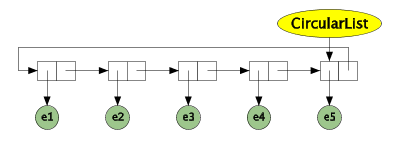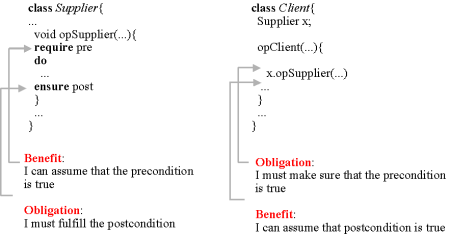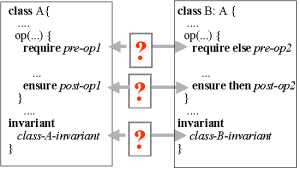| Reference |
Kurt NÝrmark ©
Department of Computer Science, Aalborg University, Denmark
| Abstract Previous lecture Next lecture Index References Contents | This lecture is about program correctness relative to specifications given by assertions. We discuss preconditions, postconditions, and invariants. The use of assertions for specifications of object-oriented program is known as Design by Contract. |
| Correctness |
| Software Qualities Slide Annotated slide Contents Index References Textbook |
|
| Table. Different program qualities listed by name, description, and (for selected qualities) a contrasting, opposite quality |
|
|
| Correctness Slide Annotated slide Contents Index References Textbook |
|
|
| Specifications Slide Annotated slide Contents Index References Textbook |
| The concept program specification: A program specification is a definition of what a computer program is expected to do [Wikipedia]. What - not how. |
|
|
| Program: An algebraic specification of a stack. |
|
| Program: An axiomatic specification of the squareroot function. |
|
| Specification with preconditions and postconditions |
| Logical expressions Slide Annotated slide Contents Index References Textbook |
| The concept logical expression: A logical expression is an expression of type boolean | ||
| The concept assertion: An assertion is a logical expression, which, if false, indicates an error [Foldoc] | ||
| The concept precondition: A precondition of an operation is an assertion which must be true just before the operation is called | ||
| The concept postcondition: A postcondition of an operation is an assertion which must be true just after the operation has been completed |
|
|
| Examples of preconditions and postconditions Slide Annotated slide Contents Index References Textbook |
|
| A circular list. The large yellow object represents the circular list as such. The circular green nodes represent the elements of the list. The rectangular nodes are instances of a class akin to LinkedListNode, which connect the constituents of the list together. |  |
| Program: Circular list with preconditions and postconditions. |
|
| An Assertion Language Slide Annotated slide Contents Index References Textbook |
|
|
| Responsibilities and Contracts |
| Questions Related to Responsibility Slide Annotated slide Contents Index References |
|
| Division of Responsibilities Slide Annotated slide Contents Index References Textbook |
|
|
|
| The highly responsible program Slide Annotated slide Contents Index References Textbook |
|
| Program: Excerpt of highly responsible class Client of BankAccount. |
|
| Program: Excerpt of highly responsible class BankAccount. |
|
| Responsibility division by pre and postconditions Slide Annotated slide Contents Index References Textbook |
|
|
|
| Contracts Slide Annotated slide Contents Index References Textbook |
|
| The concept contract: A contract expresses the mutual obligations in between parts of a program that cooperate about the solution of some problem |
|
| Everyday Contracts Slide Annotated slide Contents Index References Textbook |
|
|
| Contracts: Obligations and Benefits Slide Annotated slide Contents Index References Textbook |
| Figure. A give-and-take situation involving a client and a server (supplier) class. |  |
|
| Obligations and Benefits in Sqrt Slide Annotated slide Contents Index References Textbook |
| Program: An axiomatic specification of the squareroot function. |
|
| Table. A tabular presentation of the obligations and benefits of the squareroot function (in a server role) and its callers (in a client role). |
|
|
| Class Invariants |
| General aspects of contracts Slide Annotated slide Contents Index References Textbook |
|
| The concept class invariant: A class invariant expresses properties of an object which are stable in between operations initiated via the public client interface |
|
| Everyday invariants Slide Annotated slide Contents Index References Textbook |
|
|
| An example of a class invariant Slide Annotated slide Contents Index References Textbook |
|
| Program: Circular list with a class invariant. |
|
|
| Inheritance is Subcontracting |
| Inheritance and Contracts Slide Annotated slide Contents Index References Textbook |
|
| Figure. The relationship between inheritance and contracts |  |
| Subcontracting Slide Annotated slide Contents Index References Textbook |
|
|
|
| Class invariants in the triangle class hierarchy Slide Annotated slide Contents Index References Textbook |
| Figure. Most general triangle: 3 non-zero angles 3 non-zero edges Sum of angles: 180 degrees Isosceles triangle Equilateral triangle: Right triangle: Isosceles right triangle: |  |
|
| Assertions in Abstract classes Slide Annotated slide Contents Index References Textbook |
|
| Program: An abstract class with preconditions and postconditions. |
|
|
| Design by Contract |
| Design by Contract Slide Annotated slide Contents Index References Textbook |
|
|
| DBC and Programming Languages Slide Annotated slide Contents Index References Textbook |
|
|
|
|
| Code Contracts in C# 4.0 Slide Annotated slide Contents Index References |
|
|
| Loop Invariants |
| Loop Invariants Slide Annotated slide Contents Index References |
|
| Program: Division by repeated subtraction. |
|
| Program: Output of the division program. |
|
| Program: Division by repeated subtraction - instrumented with output inside loop. |
|
| Program: Output of the instrumented division program. |
|
Chapter 13: Contracts and Assertions
Course home Author home About producing this web Previous lecture (top) Next lecture (top) Previous lecture (bund) Next lecture (bund)
Generated: February 7, 2011, 12:22:05